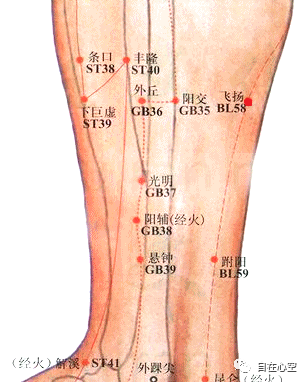Foot Taiyang Collateral, one of the fifteen collaterals, is a branch of the Foot Taiyin Spleen Meridian. The acupuncture point is Gong Sun (公孙), located 1 cun posterior to the base of the big toe, branching into the Foot Yangming Stomach Meridian. Its branch enters the abdomen and connects with the intestines and stomach; if its qi ascends abnormally, it can lead to cholera. According to the Ling Shu – Jing Mai: “The branch of the Foot Taiyang is called Fei Yang (飞扬), located 7 cun above the ankle, and it branches towards the Foot Shaoyin Kidney Meridian.” This indicates that this collateral branches from the Fei Yang point, which is 7 cun above the external malleolus, and travels towards the Foot Shaoyin Kidney Meridian. When this collateral is affected, it can manifest as a runny nose with clear discharge, nasal congestion, headache, and back pain; if deficient, it may present as a runny nose with clear discharge and nasal bleeding.
【Fei Yang Point】

Fei Yang, also known as Jue Yang (厥阳). The name explanation: “Fei” refers to the material within the point being the qi of the celestial region. “Yang” indicates that the material within the point rises and ascends. The name Fei Yang signifies that the qi and blood of the Bladder Meridian ascend and absorb heat here. The material at this point is the damp qi that rises and absorbs heat from the Bladder Meridian, and its transformation at this point is further heat absorption and vaporization, hence the name Fei Yang Point.
Location: On the posterior aspect of the lower leg, 7 cun above the external malleolus, 1 cun below the point Cheng Shan (承山).
Method of Locating: First locate Cheng Shan (while lying prone, find the midpoint of the popliteal crease behind the knee and the line connecting it to the tip of the external malleolus; this is Cheng Shan point), then move 1 horizontal finger breadth down and 1 horizontal finger breadth laterally to find the point.
Functions: Clears heat, calms the spirit, relaxes the muscles, and activates the collaterals.
Indications: Disorders of the waist, legs, and ankles, such as headache, dizziness, epistaxis, stiff neck, low back and leg pain, weakness of the knees and shins, abdominal pain during menstruation, foot weakness, gout, inability to flex or extend the toes, chills and fever, hemorrhoids, mania, nasal congestion, low back pain, weakness of the legs, hemorrhoids, neck pain, low back and knee pain, epilepsy, beriberi. In modern practice, Fei Yang Point is often used to treat rheumatoid arthritis, nephritis, cystitis, sciatica, lower limb paralysis, hemorrhoids, and dizziness.
Needling Method: Insert the needle perpendicularly 1 to 1.5 cun, with local soreness and distension; the sensation may radiate down the leg.
Moxibustion Method: Apply moxa cones or warm needle moxibustion for 3 to 5 cones, or use moxa sticks for 5 to 10 minutes.

